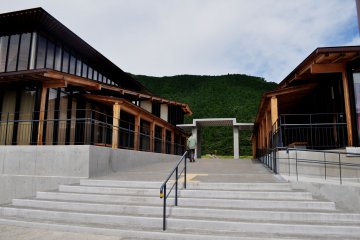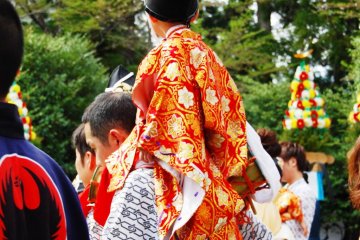When you walk the Kumano Kodo pilgrimage trails, located in the south of Wakayama Prefecture, you come to Hongu Town and the Hongu Taisha, one of the Three Kumano Grand Shrine. If your walk happens in mid-April, then you might have a chance to witness the Hongu Taisha Spring Festival.
This is a local spectacle that does not draw millions of visitors like spring festivals elsewhere in Japan. This allows you to see everything close-up. The crowd consists mainly of locals which gives you a chance for a chat. After the prayer rituals and spiritual ceremonies comes the fun, which consists of eating, drinking and playing. Some local delicacies and local sake is shared around and soon all participants are in a festive mood.
The spring festival at the Hongu Taisha (April 13th to 15th) gets absolutely everyone in Hongu Town—from the young to the old—to participate to keep traditions alive. First a ceremony takes place at Hongu where a procession is forming. Then this procession makes its way from the shrine to Oyunohara, a sandbank in the Kumano River and one of Kumano’s most holy sites.
Oyunohara is now a wide open space but it used to be the place where the Hongu Shrine once stood before it got washed away by a flooding in the late 19th century. Here a series of sacred ceremonies are performed to honor the Kumano Deities and the tradition of the Kumano Kodo pilgrimage.
Participants wear Heian-style period costumes making for an authentic experience much to the enjoyment of visitors who join the locals in their festivities. The Heian Period of Japanese history (9th to 12th century) is when the Kumano Kodo pilgrimage became popular amongst aristocrats and re-tired emperors who did the long journey all the way from Kyoto. Actually, Kyoto and Kumano are still linked nowadays and many visitors to Kumano come from Kyoto with a stop at Koyasan, the mountain monastery in the north of the Kii Peninsula, before walking the Kumano Kodo trails in the south. Both Koyasan and Kumano are considered the "spiritual heartland" of Japan and they are located in Wakayama Prefecture.
















